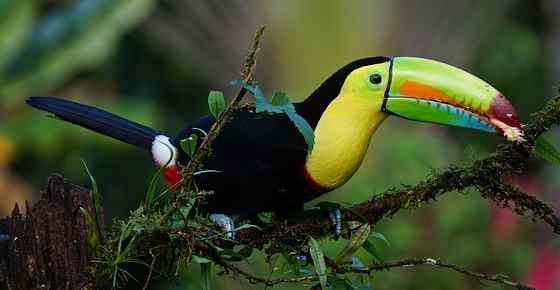The biodiversity of animals and plants in tropical rainforests is extraordinary, with many species found nowhere else. Exotic birds, vivid frogs, enormous insects, and huge cats are among the creatures that may be found in tropical rainforests. The rainforest biome is further enhanced by Rainforest plants such as big trees, lovely orchids, unusual blooms, and delectable fruits.
The flora and animals that make up the ecosystem are known as tropical rainforest biome. According to some estimates, rainforests are home to 50–75% of all plants, animals, and creatures. Brazil, Peru, the Philippines, Indonesia, Congo, and Papua New Guinea are among the countries with rainforests. The jungles are home to a variety of tropical rainforest creatures (fauna). Many plants, insects, amphibians, spiders, small mammals, and lizards live on the forest floor, which is generally dark and damp.
The middle portion of the flora system is known as the understory layer. Birds, lizards, snakes, and big predatory cats all live in this forest environment. Between 98 and 148 feet (30 and 45 meters) above the forest floor, the canopy layer is the most diverse portion of the rainforest ecosystem. It is claimed to house 50% of all plant species in the world and is home to a wide variety of flora and fauna.
Tropical Rainforest Plants
Just a few types of flora exist exclusively in rainforests in tropical parts of the globe. Around 170,000 of the world’s plant species are thought to be contained in these. Several plant species are unable to thrive in the woodland since there is insufficient light. In rainforests, plants such as ferns and fungus flourish in the damp humid environment. Exotic orchids, climbing plants, and ficus types may be found higher up in the understory.
Several of the world’s coolest and strangest plants may be found in tropical rainforests. Some of the intriguing plants you may discover include carnivorous plants, corpse plants, and kissing lips. Of course, the forest biome is dominated by big broadleaf trees. Some large rainforest trees include rubber trees, giant Shorea trees, banana plants, Cecropia plants, and huge red cedars.
Rainforest plants play a significant part in animal life as well. Plants offer animals protection and a place to hide from predators, in addition to being a source of food.
Tropical Rainforest Animals
In this article, I couldn’t possibly list all of the tropical rainforest animals. Read on to learn about some of the most beautiful and unusual creatures that call tropical rainforests home.
Macaws

The bright colors, large strong bills, and long tail feathers distinguish macaws, which are parrots that live in rainforests. The Psittacidae family of Macaws contains six genera, and they are all members of this family.
Macaws are a rare species in the wild, and they can be found in South America’s rainforests. Macaws come in a variety of colors, ranging from brilliant blue to fiery yellow and red. Many people like having macaws as a pet bird, despite the difficulty of keeping them captive.
Toucans

Another kind of tropical bird native to Central and South American rainforest canopy is toucans (Ramphastidae). These unusual birds with their huge colorful bills are divided into around 43 species. Toucans that have bills that are more than half their body length are classified as juvenile toucans.
In tropical regions of the globe, these birds are also social and may be seen in small flocks. Omnivores, these tropical birds consume plants, fruits, snakes, and tiny mammals in addition to plants and fruits.
Jaguars
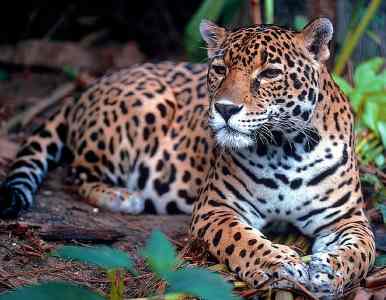
The largest of the big cats native to North and South America is the jaguar (Panthera onca). The environment of tropical rainforests is preferred by these magnificent cats. These are accomplished swimmers who can climb trees and stalk their prey on the forest floor. Jaguars have leopard-like patterns and are commonly tawny yellow.
The black panther is one of the most beautiful jaguar species. Jaguars are important members of tropical rainforest ecosystems and occupy the top of the food chain. Despite their importance as a top predator, the survival of these giant cats in the wild is insecure.
Lemurs

Lemurs are indigenous to Madagascar’s rainforests and belong to the order Primates and the Lemuroidea superfamily. The tiny size, long tail, and black around their eyes distinguish these monkey-like creatures. The ring-tailed lemurs are some of the most well-known species of lemurs. Lemurs are now listed as a critically endangered species due to human activity and environmental threats.
Aye-Aye

Like other lemurs, the aye-aye (Daubentonia madagascariensis) is native only to Madagascar. The only time the rainforest aye-ayes come out is at night. For the same reason that other lemurs are endangered, these nocturnal primates are. The height of an aye-aye is around 3 feet. Scruffy blackish fur, a long tail, and a long scruffy tail. The long middle finger used by aye-ayes to extract grubs from holes is one of their distinguishing characteristics.
Anteater

Anteaters (Vermilingua) are forest-dwelling animals that feel at home on tropical grasslands. They feed on ants and other tiny creatures, and their scientific name means “worm tongue.” Anteaters prefer tropical rainforests, arid woods, savannas, and grasslands as their natural habitats.
Anteaters come in four different sizes, varying from the petite size of a cat to the enormous anteater, which measures over 7 feet (2.17 meters). Anteaters are mainly found on the forest floor and grasslands, where they seek out ants and termites. They do, however, climb trees to forage for food.
Poison Dart Frogs

The superfamily Dendrobatoidea includes poison dart frogs, which are a group of colorful amphibians. They have a high concentration of poisonous chemicals, as their name suggests. In the rainforests, there are roughly 170 poisonous frogs species.
These little frogs stand out in the rainforest thanks to their vibrant colorful patterns. Their vividly hued bodies, on the other hand, serve as a deterrent to predators. Amazonian tribesmen would use the poison from poison dart frogs to make deadly blowdarts, giving them their name. Bright yellow and black, orange and black stripes, and turquoise and black leopard patterns are just a few of the fascinating color combinations.
Goliath Beetles

The term “goliath beetle” refers to a huge species of beetle that lives in Africa’s tropical jungles. These huge anthropoids may reach a length of 4.3 inches (11 cm) as adults, and as larvae, they may weigh up to 3.5 ounces (100 g). Goliath beetles exist in tropical rainforests and are divided into five different species. Black, brown, or white male beetles are possible. Goliath beetles are all-flying insects with bright white decorations on their bodies.
Giraffe Weevil

The long-necked giraffe weevil, which lives in Madagascar’s rainforest, belongs to the beetle family (order Coleoptera). The bright red body and long giraffe-like neck of the giraffe weevil (Trachelophorus giraffa) identify it. The giraffe weevil is one of over 97,000 different species of weevils. Giraffe weevils are exclusively found in Madagascar, similar to lemurs.
Fire Ants

Ants (genus Solenopsis) live in the South American rainforests and are a kind of insect that can be found throughout the world. The color of the bodies of these stinging insects is linked to their common names. Red ants may be found in a variety of rainforest environments, including the Amazon.
Solenopsis invicta, a kind of ant, is currently a invasive species in numerous nations. The ant is also known as the red imported fire ant for this reason. Because of their red ants’ resilience, they are unlikely to become extinct in the near future.
Arrau Turtles
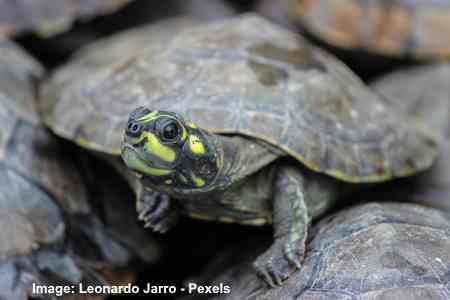
Several animals found in the Amazon rainforest dwell in freshwater as well. The Arrau turtle (Podocnemis expansa) is one of the largest turtles in the rainforest biome. These massive shelled reptiles may weigh up to 200 pounds (90 kg) and are also known as the big Amazon river turtle.
The Amazon and Orinoco rivers are home to Arrau turtles. Tropical plant leaves, seeds, fruits, and algae are among the foods they consume. They are thought to have a low conservation risk, but conservationists are worried about their dwindling numbers.
Boa Constrictor

The Boa constrictor scientific name is the same as its common moniker. Tropical rainforests and deserts are natural habitats for this large South American reptile. The ideal living environment for these huge snakes is the damp rainforest biome and foliage, however.
The snake can reach a maximum length of 13 feet (4 meters). Their powerful bite can be very painful, even if they are not poisonous. These powerful snakes crush and then devour their victims whole. Boas prefer to spend most of their time in the undergrowth on the forest floor and seldom ascend up trees due to their weight.
Anacondas

The scientific name for anacondas is Eunectes murinus, and they belong to the Boidae family. The green anaconda is a huge snake that lives in the Amazon basin. These ginormous snakes, often known as water boas, prefer to live in the Amazonian rainforest rivers and lakes. Tropical fish, caimans, wild pigs, birds, and rodents are among the animals they eat. They live in freshwater and on land.
Caiman

The Caiman (Caiman latirostris) is a little crocodile that belongs to the Alligatoridae family. In the Amazon basin rainforests, lakes and rivers, these reptiles may be found. Jaguars and anacondas are the only predators of caiman in the tropical Amazon rainforest. These little crocodiles eat fish, tiny mammals, and insects in addition to fissile species of them.
Iguana

The iguana is another animal that thrives in the rainforest environment. These enormous lizard-like animals prefer to lay eggs or mate in the rainforest canopy, which they will descend from trees. The most common of the two iguana species is the green iguana (Iguana iguana).
These snake-like creatures are common household pets that grow to be about 50 feet (15 meters) long. Because of habitat destruction, the other species, the Lesser Antilles, is considered endangered. The wet climate of Brazilian rainforests is ideal for green iguanas. They have a good sense of hearing and smell, and they camouflage well in the forest canopy.
Capybara
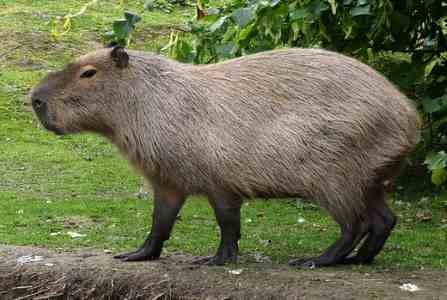
The capybara (Hydrochoerus hydrochaeris) is one of the most unusual animals found in tropical rainforests. These are a big aquatic rodent that feels at ease in both water and on land. It literally means “water hog” in scientific terms, and it reaches 6ft. (1.8 m) in length. It eats plants and grasses, with reddish-brown fur. Rivers, bogs, ponds, and lakes are their preferred rainforest dwelling places. There is no danger of extinction because they adapt readily to diverse situations.
Goliath Birdeater

A large number of spiders live in the world’s rainforests. A spider that causes feelings of dread and terror is the Goliath birdeater spider (Theraphosa blondi). The Goliath spider, which can grow to be 12 inches (30 centimeters) in leg span, is named for its size.
This kind of spider preys on birds only infrequently, despite its moniker as a “bird eater.” Rodents, insects, snakes, and amphibians make up the majority of its diet. These Goliath birdeaters have fangs that can inflict a nasty, but non-lethal bite because they are members of the tarantula family.
Rainforest Monkeys

In the uppermost branches of the rainforest canopy, monkeys may be found, and there are numerous monkey species. The Amazon rainforest is home to 430 different species of monkeys. In South American and Asian rainforests, you may see a few monkey species:
Howler monkeys. These are thought to be the world’s loudest animals. In the Amazon rain forest, they are also the biggest monkey species.
Spider monkeys. These monkeys are known as spider monkeys because of their long limbs. Spider monkeys are endangered in all seven species.
Capuchin monkeys. These little monkeys are some of the rainforest’s cutest and brightest.
Orangutans. Orangutans are a huge kind of ape that is on the critically endangered list and are native to Borneo and Sumatra’s rainforests.
Sloth
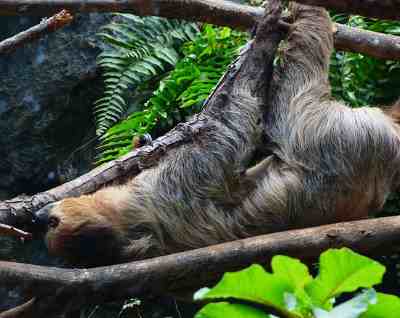
Sloths (Folivora) mostly hang upside down in the rainforest canopy, only moving when they must. Sloths are found in the South and Central American woods and there are six different species. Sloths are well-known for their slothlike sluggish movements and tree-based lifestyle.
They can swim if they have to, despite their lack of mobility on the ground. Algae grow on sloths’ gray fur, which is another fascinating characteristic. This aids them in blending into their surroundings and giving them nutrition.
Blue Morpho Butterflies
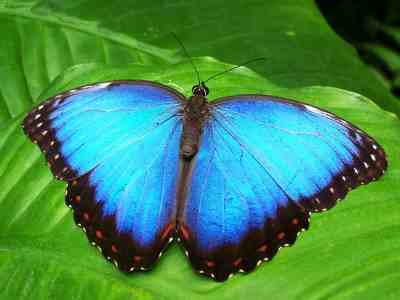
Morpho butterflies, which belong to the Nymphalidae butterfly family, are some of the most beautiful butterflies in the world. The iridescent hues of metallic greens or blues on the wings of these huge flying insects are spectacular. Blue morpho butterflies have beautiful bright blue wings in six different species.
These beautifully delicate butterflies may be seen fluttering through the undergrowth of Brazilian, Central American, and Peruvian rainforests. In addition, in large groups, these butterflies fly high above the forest canopy.
Piranhas
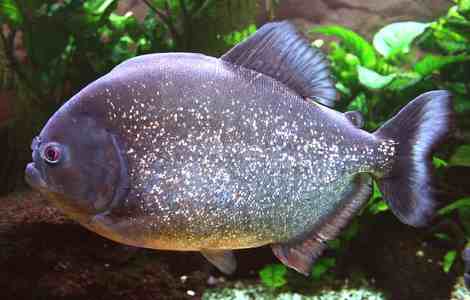
A variety of freshwater tropical fish may be found in the Amazon River, including piranhas. Piranhas are associated to tetras and silver dollar fish, which are members of the Characidae family of aquarium fish. Piranhas, which may reach sizes of 5 to 14 inches (12 to 35 cm), are omnivorous fish.
Other fish and freshwater plants are their food sources. Piranhas are generally timid around humans and can only attack when they are aroused, contrary to popular belief. Bites are usually harmless in terms of injuries.
